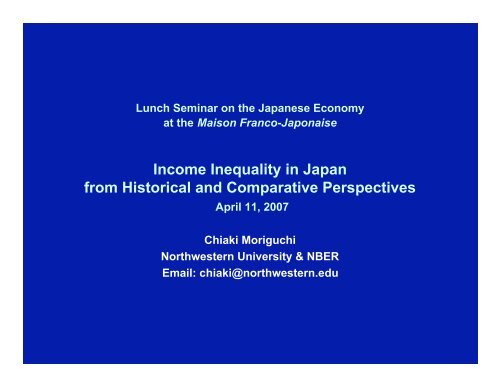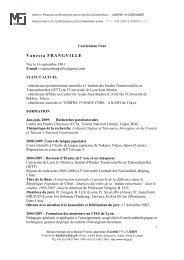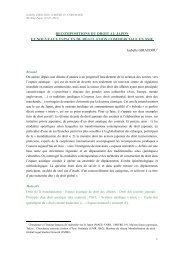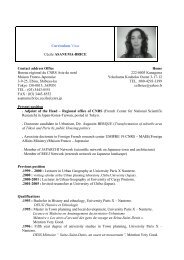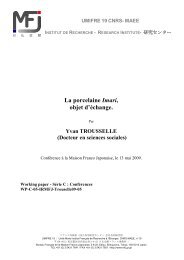PDF version - Maison Franco-Japonaise
PDF version - Maison Franco-Japonaise
PDF version - Maison Franco-Japonaise
- No tags were found...
Create successful ePaper yourself
Turn your PDF publications into a flip-book with our unique Google optimized e-Paper software.
Lunch Seminar on the Japanese Economy<br />
at the <strong>Maison</strong> <strong>Franco</strong>-<strong>Japonaise</strong><br />
Income Inequality in Japan<br />
from Historical and Comparative Perspectives<br />
April 11, 2007<br />
Chiaki Moriguchi<br />
Northwestern University & NBER<br />
Email: chiaki@northwestern.edu
Today's Talk<br />
Part 1. Income Inequality in Japan from Historical Perspectives<br />
– Is today's Japan "equal society"<br />
– If so, since when<br />
– How did it happen<br />
New findings from Moriguchi and Saez (2006).<br />
Part 2. Income Inequality in Japan from Comparative Perspectives<br />
– Is Japan's historical experience unique<br />
– What can other countries' experience tell us<br />
Recent findings from high income studies in major OECD countries by<br />
Atkinson, Piketty, Saez et al. (2006).<br />
2
Income Inequality in Japan: What We Know<br />
♦<br />
Japan widely perceived as "equal society."<br />
OECD income distribution studies<br />
– Sawyer (1976)<br />
– Atkinson et al. (1995)<br />
♦<br />
Is income inequality rising in Japan<br />
– Tachibanaki (2001): "Equal society is a myth."<br />
– Ohtake (2005): "Increase in inequality due to demographic change,<br />
not due to structural change."<br />
3
Income Inequality in OECD Countries in the late 1980s<br />
Table A: Income Before Tax & Transfers<br />
Table B: Income After Tax & Transfers<br />
Country Year Gini Coeficient Country Year Gini Coefficient<br />
Ireland 1987 0.461 U.S. 1986 0.347<br />
Sweden 1987 0.439 Switzerland 1982 0.346<br />
U.K. 1986 0.428 Ireland 1987 0.341<br />
France 1984 0.417 U.K. 1986 0.323<br />
U.S. 1986 0.411 Italy 1986 0.321<br />
Switzerland 1982 0.407 France 1984 0.311<br />
Germany 1984 0.395 Canada 1987 0.305<br />
Finland 1987 0.379 Japan 1985 0.298<br />
Canada 1987 0.374 Sweden 1987 0.281<br />
Italy 1986 0.361 Germany 1984 0.277<br />
Netherlands 1987 0.348 Netherlands 1987 0.266<br />
Japan 1989 0.317 Belgium 1988 0.260<br />
Belgium 1988 0.273 Finland 1987 0.255<br />
Source: Nishizaki et al. (1998) Source: Kokumin Seikatsukyoku (1999), Chapter 3;<br />
Atkinson et al. (1996), Table 4-10.<br />
4
Income Inequality in Japan, 1955-2005<br />
0.55<br />
0.50<br />
0.45<br />
EES/FIES<br />
PLCS1<br />
PLCS2<br />
IRS<br />
HHS<br />
Gini Coefficient<br />
0.40<br />
0.35<br />
0.30<br />
0.25<br />
0.20<br />
1956 1962 1968 1974 1980 1986 1992 1998 2002<br />
5
Income Inequality in Japan, 1890-2005<br />
Gini Coefficient<br />
0.70<br />
0.65<br />
0.60<br />
0.55<br />
0.50<br />
0.45<br />
0.40<br />
0.35<br />
EES/FIES<br />
PLCS1<br />
PLCS2<br />
HHS<br />
IRS<br />
WD/NIT<br />
LESJ<br />
NIT/LIT<br />
0.30<br />
0.25<br />
0.20<br />
1890 1900 1910 1920 1925 1935 1940 1950 1959 1966 1971 1977 1983 1989 1995 2001 2003<br />
6
Income Inequality in Japan, 1890-2005<br />
0.70<br />
0.65<br />
0.60<br />
0.55<br />
Gini Coefficient<br />
0.50<br />
0.45<br />
0.40<br />
0.35<br />
0.30<br />
0.25<br />
0.20<br />
1890 1900 1910 1920 1925 1935 1940 1950 1959 1966 1971 1977 1983 1989 1995 2001 2003<br />
7
What We Don't Know<br />
♦ No data between 1940 and 1955.<br />
♦<br />
Pre-1940 data only for selected years.<br />
♦<br />
Can not compare the levels of pre-1940 series and post-1955 series<br />
due to data discontinuity.<br />
♦<br />
Japan became an "equal society" by 1970 — but how<br />
♦<br />
Little knowledge on high income groups.<br />
8
High Income Studies using Income Tax Statistics<br />
♦ Pioneered by Piketty (2003) and Piketty & Saez (2003).<br />
♦<br />
Construct long-run, homogenous, and continuous top income shares<br />
series using income tax statistics.<br />
♦<br />
Precise data on the level and composition of the high-end of income<br />
distribution (not available in household surveys).<br />
♦<br />
Document the evolution of income concentration over many decades.<br />
♦<br />
Facilitate international comparison of the experience of major<br />
economies — France, U.K., U.S., Netherlands, Sweden, etc.<br />
9
Studying Japan<br />
♦ Comprehensive income tax system introduced in 1887.<br />
Cf: U.K. in 1908, France in 1910, U.S. in 1913.<br />
♦ Income tax statistics published every year since 1887 to date.<br />
♦ Because Japan's modern economic growth started circa 1886,<br />
the data span the entire process of industrialization.<br />
♦ Investigate the relationships between economic growth and<br />
income inequality.<br />
10
Real Income per Capita in Japan, 1885-2002<br />
10,000<br />
100.00<br />
Income in 2002 thousands of Yen<br />
1,000<br />
Real Income per Capita<br />
CPI 2002<br />
10.00<br />
1.00<br />
0.10<br />
100<br />
1885<br />
1890<br />
1895<br />
1900<br />
1905<br />
1910<br />
1915<br />
1920<br />
1925<br />
1930<br />
1935<br />
1940<br />
1945<br />
1950<br />
1955<br />
1960<br />
1965<br />
1970<br />
1975<br />
Consumer Price Index (base 100 in 2002)<br />
1980<br />
1985<br />
1990<br />
1995<br />
2000<br />
0.01<br />
11
Methodology<br />
♦<br />
♦<br />
♦<br />
<br />
<br />
<br />
Income before tax (wages & bonuses; business, farm & self-employed<br />
incomes; interest, dividends & rents, but exclude capital gains).<br />
Top income groups (10%, 1%, 0.1%, 0.01%) defined relative to total<br />
number of adults.<br />
Top 1% income share<br />
= incomes accrued to top 1% income earners / total personal income.<br />
Due to high level of income tax exemption before 1940, less than 5% of<br />
adults filed income tax returns in Japan.<br />
"Reported income" subject to tax evasion & avoidance.<br />
Due to numerous tax reforms and revisions, need careful adjustments<br />
to create homogenous series.<br />
12
Top 1% and Next 4% Income Shares in Japan, 1886-2002<br />
22%<br />
20%<br />
18%<br />
Top 1%<br />
Top 5-1%<br />
16%<br />
14%<br />
12%<br />
10%<br />
8%<br />
6%<br />
4%<br />
1886<br />
1890<br />
1894<br />
1898<br />
1902<br />
1906<br />
1910<br />
1914<br />
1918<br />
1922<br />
1926<br />
1930<br />
1934<br />
1938<br />
1942<br />
1946<br />
1950<br />
1954<br />
1958<br />
1962<br />
1966<br />
1970<br />
1974<br />
1978<br />
1982<br />
1986<br />
1990<br />
1994<br />
1998<br />
2002<br />
Income share<br />
13
Decomposition of Top 1% Income Share in Japan, 1886-2002<br />
10%<br />
9%<br />
8%<br />
7%<br />
Top 0.1%<br />
Next 0.4%<br />
Bottom 0.5%<br />
6%<br />
5%<br />
4%<br />
3%<br />
2%<br />
1%<br />
0%<br />
1886<br />
1890<br />
1894<br />
1898<br />
1902<br />
1906<br />
1910<br />
1914<br />
1918<br />
1922<br />
1926<br />
1930<br />
1934<br />
1938<br />
1942<br />
1946<br />
1950<br />
1954<br />
1958<br />
1962<br />
1966<br />
1970<br />
1974<br />
1978<br />
1982<br />
1986<br />
1990<br />
1994<br />
1998<br />
2002<br />
Income share<br />
14
Top 0.1% Income Share with Capital Gains in Japan<br />
10%<br />
9%<br />
8%<br />
Without Capital Gains<br />
With Capital Gains<br />
7%<br />
6%<br />
5%<br />
4%<br />
3%<br />
2%<br />
1%<br />
0%<br />
1886<br />
1890<br />
1894<br />
1898<br />
1902<br />
1906<br />
1910<br />
1914<br />
1918<br />
1922<br />
1926<br />
1930<br />
1934<br />
1938<br />
1942<br />
1946<br />
1950<br />
1954<br />
1958<br />
1962<br />
1966<br />
1970<br />
1974<br />
1978<br />
1982<br />
1986<br />
1990<br />
1994<br />
1998<br />
2002<br />
Income share<br />
15
Composition of Top 1% Income in Japan, 1886-2002<br />
20%<br />
18%<br />
16%<br />
14%<br />
12%<br />
10%<br />
8%<br />
6%<br />
4%<br />
2%<br />
0%<br />
1886<br />
1890<br />
1894<br />
1898<br />
1902<br />
1906<br />
1910<br />
1914<br />
1918<br />
1922<br />
1926<br />
1930<br />
1934<br />
1938<br />
1942<br />
1946<br />
1950<br />
1954<br />
1958<br />
1962<br />
1966<br />
1970<br />
1974<br />
1978<br />
1982<br />
1986<br />
1990<br />
1994<br />
1998<br />
2002<br />
Income Share<br />
Employment<br />
Business<br />
Rents<br />
Interest<br />
Dividends<br />
16
Top 0.01% vs. Top 1-0.5% Estate Sizes in Japan, 1905-2002<br />
Top 0.01% Estate (in 2002 thousand yen)<br />
100,000,000<br />
10,000,000<br />
1,000,000<br />
100,000<br />
Top 0.01% estate<br />
Top 1-0.5% estate<br />
10,000<br />
1905<br />
1910<br />
1915<br />
1920<br />
1925<br />
1930<br />
1935<br />
1940<br />
1945<br />
1950<br />
1955<br />
1960<br />
1965<br />
1970<br />
1975<br />
1980<br />
1985<br />
1990<br />
1995<br />
2000<br />
1,000,000<br />
100,000<br />
10,000<br />
1,000<br />
Top 1-0.5% Estate (in 2002 thousand yen)<br />
100<br />
17
Top Estate Compositions in Japan: 1935, 1950, and 1987<br />
Estate Composition<br />
Year<br />
Agricultural<br />
Land<br />
Residential<br />
Land<br />
Houses &<br />
Structures<br />
Business<br />
Assets<br />
Stocks<br />
Fixed Claim<br />
Assets<br />
Other Assets<br />
1935 22.5% 13.8% 8.4% 3.9% 25.9% 22.6% 2.9%<br />
1950 11.8% 15.1% 37.3% 13.5% 4.8% 12.1% 19.7%<br />
1987 20.6% 43.6% 3.7% 0.8% 10.2% 11.7% 9.5%<br />
18
Historical Explanations (1):<br />
High Income Concentration in 1886-1938<br />
♦ Top 1% income group receiving 18% of total income in 1900-38.<br />
♦ Top 0.1% income group receiving 8% of total income in 1900-38.<br />
♦ Capital income component roughly 40% of top 1% income before 1938.<br />
Reasons (Yazawa 1992; Okazaki 2000):<br />
1) Concentration of land ownership to “absentee landlords.”<br />
2) Large shareholders receiving high dividends.<br />
3) Large year-end bonuses paid to CEOs.<br />
4) Primogeniture with low estate tax rates.<br />
5) Low marginal income tax rates.<br />
19
Historical Explanations (2):<br />
Income De-concentration during WWII<br />
♦ Top 1% income share fell from 20% to 7% in 1938-45.<br />
♦ Top 0.1% income share fell from 9% to 2% in 1938-45.<br />
♦ Collapse of capital income component in top 1% income in 1938-45.<br />
♦ Top 1% wage income share fell from 8% to 3% in 1935-44.<br />
Reasons (Nishida 2003; Okazaki 2000; Yazawa & Minami 1993) :<br />
– 1938 General Mobilization Act (regulation on land rents, dividends,<br />
wages and bonuses in 1939-45)<br />
– Increases in income tax rates in 1938-45.<br />
– Wartime inflation in 1938-45.<br />
– War destruction in 1944-45.<br />
20
♦<br />
Historical Explanations (3):<br />
Impact of U.S. Occupational Reforms (1947-52) Reconsidered<br />
Occupational policies:<br />
Land reform in 1947-50,<br />
Zaibatsu dissolution in 1946-48,<br />
Property tax in 1946-51.<br />
with Hyperinflation in 1944-48.<br />
Considered to be major causes of income equalization (Minami 1995).<br />
Then why no impact on top income shares<br />
Explanations:<br />
– Discontinuity in data Tax reforms in 1940, 1947, 1950, but unlikely to<br />
produce large enough bias.<br />
– Occupational reforms largely continuation of wartime policies (Dore<br />
1985; Gordon 1985; Okazaki 2000; Moriguchi 2000).<br />
– Played big role in (not income but) wealth redistribution.<br />
21
Historical Explanations (4):<br />
Why Did Not Top Income Shares Recover after WWII<br />
♦ Top 1% income share remains stable at 8% in 1950-2002.<br />
♦ Top 0.1% income shares remains at 2% in 1950-2002.<br />
♦ Top 1% "wage income" share remains at 7% in 1970-2002.<br />
Reasons: Changes in institutional infrastructure after WWII:<br />
– Primogeniture abolished in 1947,<br />
– Progressive estate tax since 1950,<br />
– Progressive individual & corporate income tax since 1950,<br />
– Restrictive land and house lease laws since 1941,<br />
– Tax-exempted savings for the middle class since 1963,<br />
– Change in corporate governance (bank finance, cross shareholding),<br />
– Change in human resource management (enterprise unions, internal<br />
promotion, joint consultation).<br />
22
Marginal Income Tax Rates in Japan, 1886-2002<br />
90%<br />
80%<br />
70%<br />
60%<br />
Highest Statutory MTR<br />
Top 0.01% MTR<br />
Top 0.1% MTR<br />
50%<br />
40%<br />
30%<br />
20%<br />
10%<br />
0%<br />
1886<br />
1890<br />
1894<br />
1898<br />
1902<br />
1906<br />
1910<br />
1914<br />
1918<br />
1922<br />
1926<br />
1930<br />
1934<br />
1938<br />
1942<br />
1946<br />
1950<br />
1954<br />
1958<br />
1962<br />
1966<br />
1970<br />
1974<br />
1978<br />
1982<br />
1986<br />
1990<br />
1994<br />
1998<br />
2002<br />
Marginal Tax Rate<br />
23
Japan's Experience in Comparative Perspectives<br />
♦<br />
Top income shares series constructed by the similar methods:<br />
• France (Piketty 2003)<br />
• U.S. (Piketty and Saez 2003)<br />
• Canada (Saez and Veall 2005)<br />
• U.K. and Australia (Atkinson and Leigh 2004)<br />
• Netherlands (Atkinson and Salverda 2005)<br />
• Switzerland (Dell, Piketty, and Saez 2006)<br />
• Sweden (Roine and Waldenstrom 2006)<br />
• Japan (Moriguchi and Saez 2006)<br />
24
Top 0.1% Income Shares in France, U.K., and U.S., 1900-2005<br />
12%<br />
10%<br />
Japan<br />
France<br />
Top 0.1% Income Share<br />
8%<br />
6%<br />
4%<br />
2%<br />
0%<br />
1900<br />
1905<br />
1910<br />
1915<br />
1920<br />
1925<br />
1930<br />
1935<br />
1940<br />
1945<br />
1950<br />
1955<br />
1960<br />
1965<br />
1970<br />
1975<br />
1980<br />
1985<br />
1990<br />
1995<br />
2000<br />
2005<br />
UK<br />
US<br />
25
Top 0.1% Income Shares in Anglo-Saxon Countries, 1900-2005<br />
12%<br />
10%<br />
8%<br />
6%<br />
4%<br />
2%<br />
0%<br />
1900<br />
1905<br />
1910<br />
1915<br />
1920<br />
1925<br />
1930<br />
1935<br />
1940<br />
1945<br />
1950<br />
1955<br />
1960<br />
1965<br />
1970<br />
1975<br />
1980<br />
1985<br />
1990<br />
1995<br />
2000<br />
2005<br />
Top 0.1% Income Share<br />
Japan<br />
U.S.<br />
U.K.<br />
Canada<br />
Australia<br />
26
Top 0.1% Income Shares in Netherlands, Sweden, and<br />
Switzerland, 1900-2005<br />
12%<br />
Japan<br />
Top 0.1% Income Share<br />
10%<br />
8%<br />
6%<br />
4%<br />
Netherlands<br />
Sweden<br />
2%<br />
0%<br />
1900<br />
1905<br />
1910<br />
1915<br />
1920<br />
1925<br />
1930<br />
1935<br />
1940<br />
1945<br />
1950<br />
1955<br />
1960<br />
1965<br />
1970<br />
1975<br />
1980<br />
1985<br />
1990<br />
1995<br />
2000<br />
2005<br />
Switzerland<br />
27
Is Japan's Experience Unique<br />
♦<br />
In most OECD countries, income concentration was once extremely<br />
high, and then fell dramatically during 1910-1945.<br />
♦<br />
Decline in top income shares during WWII seen in all participating<br />
countries (including winners), but was most dramatic in Japan.<br />
♦<br />
Top income shares have increased sharply since 1980 in Anglo-Saxon<br />
countries (but remained low elsewhere). Rise in executive<br />
compensation in the U.S. considered to be major driving force.<br />
28
Main Results & Conclusions<br />
♦<br />
♦<br />
♦<br />
♦<br />
♦<br />
Income concentration in Japan was high throughout the 1885-1938 period,<br />
then declined dramatically during WWII.<br />
Collapse of top capital income during WWII was the primary reason for the<br />
income de-concentration. Wage income concentration also fell sharply<br />
during WWII.<br />
Postwar institutional reforms made the one-time income de-concentration<br />
irreversible. Both capital income and wage income became much more<br />
equally distributed after WWII.<br />
Japan achieved two "economic miracles" under very different social, legal,<br />
and institutional settings. No clear relationships between income inequality<br />
and economic growth.<br />
The process of income de-concentration driven mainly by large historical<br />
shocks (wars, depressions) that destroyed wealth or triggered government<br />
intervention. Important policy implications for developing countries.<br />
29


